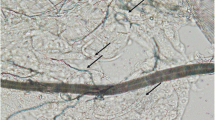Summary
Continuous breeding of the African land snail, Achatina fulica (African Giant Snail) has been successfully carried out over a period of more than two years under laboratory conditions which are described in detail. Some data are presented on the biology and anatomy of this snail species.
Achatina fulica proved to be susceptible for experimental infections with first-stage larvae of Angiostrongylus vasorum (strain Switzerland). The third-stage larvae, isolated from the snails 17 days after exposure, were infective for a dog. The possible epizootological importance of this finding is discussed.
Compared with Achatina fulica the tropical fresh water snail, Biomphalaria glabrata, is more susceptible to infection with A. vasorum or the rat parasite A. cantonensis. However, infected Achatina fulica have a higher survival rate, and larger absolute numbers of third-stage larvae can be gained from this species which tolerates infection doses of 5000, 10000 and 20000 larvae per animal, respectively. In young snails the last mentioned dose caused shell abnormalities and depression of growth.
Specimens of Achatina fulica were successfully infected by exposure to a larval suspension (“percutaneous/peroral infection”) or by injection of larvae into the foot musculature, the gastrointestinal tract or into the mantle cavity. In all cases infective larvae were found in the lung, foot, mantle, liver, and gastrointestinal tract. The highest density of larvae (number of larvae per gram of tissue) was observed in the lung. There is a positive correlation between the infection dose and the yield of third-stage larvae in absolute figures. However, the percentage was independent from the doses of infection and varied between 3–15 percent.
Achatina fulica is therefore a suitable snail for the production of large numbers of infective larvae of A. vasorum.
Zusammenfassung
Die afrikanische Landschnecke, Achatina fulica (Afrikanische Riesenschnecke, Achatschnecke), wurde während eines Zeitraumes von mehr als 2 Jahren erfolgreich unter Laborbedingungen gezüchtet, die näher beschrieben werden. Zur Biologie und Anatomie dieser Schneckenart werden einige Daten angegeben.
Achatina fulica erwies sich für experimentelle Infektionen mit ersten Larven von Angiostrongylus vasorum (Stamm Schweiz) als empfänglich. Die aus den Schnecken nach 17 Tagen isolierten dritten Larven waren für einen Hund infektiös. Die mögliche epizootologische Bedeutung dieses Befundes wird diskutiert.
Im Vergleich zu Achatina fulica ist die tropische Süßwasserschnecke, Biomphalaria glabrata, für Infektionen mit A. vasorum oder A. cantonensis, einem Rattenparasiten, empfänglicher. Infizierte Achatina fulica haben jedoch eine höhere Überlebensrate, und es können absolut mehr dritte Larven aus dieser Schneckenart gewonnen werden, die Infektionsdosen von 5000, 10000 und 20000 Larven pro Tier erträgt. Bei jungen Schnecken verursacht die letztgenannte Dosis Abnormitäten der Schale und Wachstumshemmung.
Achatina fulica ließ sich durch Einsetzen in eine Larvensuspension (“perkutane/perorale Infektion”) oder durch Injektion von Larven in die Fußmuskulatur, den Magen-Darmtrakt oder in die Mantelhöhle erfolgreich infizieren. In allen Fällen wurden infektiöse Larven in der Lunge, der Leber, im Fuß, im Mantel und im Verdauungstrakt gefunden. Die höchste Larvendichte (Larvenzahl pro Gramm Gewebe) wies die Lunge auf. Zwischen der Infektionsdosis und der absoluten Zahl der gewonnenen dritten Larven besteht eine positive Abhängigkeit; der prozentuale Infektionserfolg war jedoch von der Infektionsdosis unabhängig und variierte zwischen 3–15%.
Achatina fulica ist für die Produktion großer Zahlen dritter Larven von A. vasorum geeignet.
Similar content being viewed by others
Literatur
Alicata, J. E., Jindrak, K.: Angiostrongylosis in the Pacific and Southeast Asia. Springfield, Ill., USA: Ch. C. Thomas 1970
Boch, J., Supperer, R.: Veterinärmedizinische Parasitologie. Berlin u. Hamburg: P. Parey 1971
Bequaert, J. C.: Studies in the Achatininae, a group of African land snails. Bull. Mus. comp. Zool. Harv. 105, 3–216 (1950)
Bwangamoi, O.: Angiostrongylus vasorum and other worms in dogs in Uganda. Vet. Rec. 91, 267 (1972)
Eckert, J., Lämmler, G.: Angiostrongylose bei Mensch und Tier. Z. Parasitenk. 39, 303–322 (1972)
Guilhon, J.: Rôle des limacidés dans le cycle évolutif d'Angiostrongylus vasorum (Baillet, 1866). C.R. Acad. Sci. (Paris), Sér D 251, 2252–2253 (1960)
Guilhon, J.: Recherches sur le cycle évolutif du strongle des vaisseaux du chien. Bull. Acad. vét. Fr. 36, 431–442 (1963)
Guilhon, J.: Évolution larvaire d'Angiostrongylus vasorum (Baillet, 1866) dans l'organisme d'arionidés. C.R. Acad. Sci. (Paris), Sér. D 261, 4225–4227 (1965)
Guilhon, J., Afghahi, A.: Évolution larvaire d'Angiostrongylus vasorum (Baillet, 1866) dans l'organisme de diverses espèces de mollusques terrestres. C.R. Acad. Sci. (Paris), Sér. D 268, 434–436 (1969)
Guilhon, J., Cens, B.: Migrations et évolution d'Angiostrongylus vasorum (Baillet, 1866) dans l'organisme du chien. C.R. Acad. Sci. (Paris), Sér. D 269, 2377–2380 (1969)
Guilhon, J., Gaalon, A. de: Évolution larvaire d'un nématode parasite de l'appareil circulatoire du chien dans l'organisme de mollusques dulçaquicoles. C.R. Acad. Sci. (Paris), Sér. D 268, 612–615 (1969)
Mead, A.R.: Comparative genital anatomy of some African Achatinidae (Pulmonata). Bull. Mus. comp. Zool. Harv. 105, 217–292 (1950)
Neff, H.: Experimentelle Infektionen von Hunden mit Angiostrongylus vasorum (Nematoda). Diss. Zürich (1971)
Rosen, L., Ash, L. R., Wallace, G. D.: Life history of the canine lungworm Angiostrongylus vasorum (Baillet). Amer. J. vet. Res. 31, 131–143 (1970)
Tinapp, D.: Über das Wirt-Parasit-Verhältnis bei der experimentellen Infektion des Hundes mit Angiostrongylus raillieti (Travassos, 1927). Diss. Giessen (1969)
Williams, F. X.: Life-history studies of East African Achatina snails. Bull. Mus. comp. Zool. Harv. 105, 293–317 (1951)
Author information
Authors and Affiliations
Additional information
Mit finanzieller Unterstützung durch die Stiftung für wissenschaftliche Forschung an der Universität Zürich.
Rights and permissions
About this article
Cite this article
Sauerländer, R., Eckert, J. Die Achatschnecke (Achatina fulica) als experimenteller Zwischenwirt für Angiostrongylus vasorum (Nematoda). Z. F. Parasitenkunde 44, 59–72 (1974). https://doi.org/10.1007/BF00328832
Received:
Issue Date:
DOI: https://doi.org/10.1007/BF00328832




